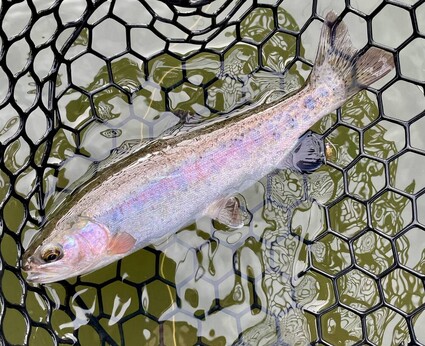The river on the eve of winter
Last updated 11/28/2023 at 11:36am
Life in Sisters Country brings us closer to the rhythms of our planet.
For example, our seasons don't follow the calendar. I was reminded of this last weekend, when I drove the 50-odd miles from Sisters to the Crooked River just below Bowman Dam.
Low clouds skidded across the sky as I entered the Crooked River Canyon, and little bursts of rain spattered on the truck windshield.
It looked like a good day for a blue-wing olive mayfly hatch. These tiny mayflies hatch out all winter on the Crooked - and on the Metolius - but they're most likely to show up on cloudy days with rain or snow. These bugs are hardy and sturdy, but they hate a strong, cold wind.
I parked near a favorite, weedy run - the Crooked below Bowman Dam is a tailwater, which means the river flows out of the bottom of a dam. Small tailgaters are usually fertile and full of aquatic weeds and insects. In a sense, they're human-made spring creeks.
As I parked, I spotted the slowly spreading rings of rising trout on the Crooked River.
Signs of winter
We're lucky to have two great rivers - the Crooked and the Metolius - that fish well all winter long.
I know that some of you are rolling your eyes at this moment. Why? The calendar says it isn't winter until December 21, and that's more than a month away. Yet, we're already getting freezing nights, we've gotten snow on the passes and, most importantly, the trout are acting as though winter is here.
What does that mean?
Well, for anglers who love to catch trout on dry flies, it means that the daily hatch (of blue-wing olive mayflies or midges or maybe a weird caddis) usually lasts for an hour or less. A few weeks ago, bugs were hatching most of the day.
When it gets cold - and the daylight is short - the bugs tend to hatch on the warmest part of the day, even if the warmest part is just 36 degrees.
On this day, blue-wing olive mayflies rode the surface currents in between mats of aquatic weeds. I rigged up quickly, as I knew that the hatch wouldn't last long. I forced myself to slow down - wading quietly out toward a spot where several nice redside rainbow trout tipped and sipped size 20 mayflies. I can fit three size 20 blue-wing olive Sparkle Dun flies on my thumbnail.
Yes, they're tiny, but they look huge when size 24 or size 22 blue-wing olives hatch.
I managed to hook a couple of nice Crooked River trout, which means that they were about 11 inches long and glistened like jewels in my landing net. The Crooked River has tons of wild trout, but most of the fish aren't huge. That said, there are 22-inch trout in this river.
Then a long, achingly bitter blast of wind sliced up the canyon, ruffling the water for about 10 minutes and blowing away the mayfly hatch. I sat on a rock for 45 minutes and hoped the mayflies would resume hatching after the wind died.
Nope.
That on/off switch of bug activity means one thing - winter is here. Okay, maybe it means that winter is almost here.
Here and gone
I got out my Euro nymphing rod and rattled tiny Zebra Midge flies on the bottom of the river. I got a couple trout, which made me happy. Euro nymphing, which is all about using a long, light leader to let tiny, heavily weighted flies drift down amongst the bottom rocks, puts the fly right in front of the fish when they're not rising.
After an hour of this, I was getting ready to go home. Then, I noticed clouds of small bugs flying overhead - and rising and falling in a dance-like ritual. Blue-wing olive spinners - the mating form of the bugs that had hatched a couple of hours before - were having sex and getting ready to lay their fertilized eggs on the river. The spinners would then flop onto the water.
This floating buffet might get the fish back up and feeding on the surface!
I grabbed my dry fly rod - it is a sickening-but-true fact that I have different (and expensive) fly rods for nymphing and dry fly fishing - and tied on a spinner pattern.
It was 3 p.m. It would be pitch dark by 5 p.m., so I expected the spinners to fall to the water at any moment.
By 4:30 p.m., some of the spinners had fallen to the water - and sparked a couple rises - but most of the wretched insects were still flying and fornicating away.
At 4:45 p.m., masses of mayfly spinners began gently settling on the surface, and two very nice trout immediately began rising right next to a huge weed bed.
I hooked a fish on the second cast, which promptly dove into the weeds and broke my 6X tippet. Time to re-rig!
At 4:55 p.m., massive gusts of frigid wind blew up the canyon and shut down the rising fish. Every one of them.
I guess it isn't winter yet, but it is almost here - at least on the trout streams.


















Reader Comments(0)